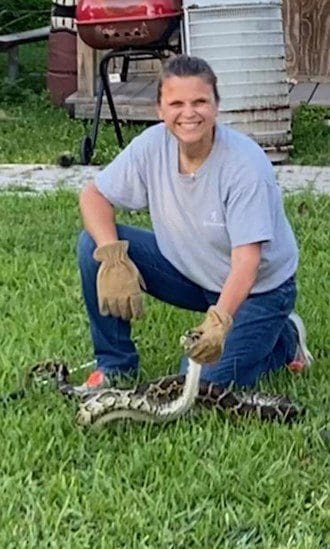Hunting the Top of the Everglades Food Chain: the Burmese Python
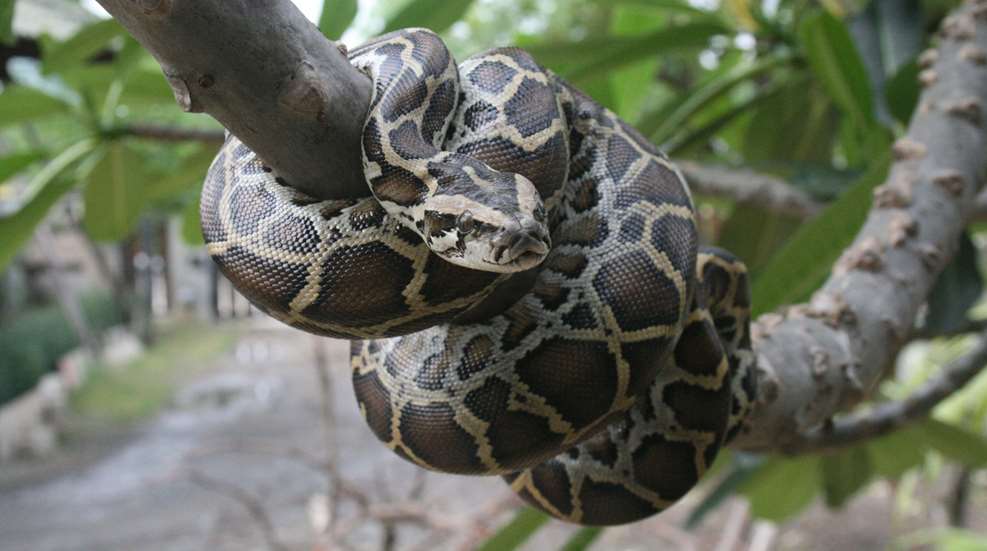
Hunting the Top of the Everglades Food Chain: the Burmese Python – NRA Women.com
Move over rattlesnake roundups, python hunts are the latest rage.
I received a phone call one day asking if I would like to participate in a hunt in Florida. Without even asking what animal I would be hunting, I enthusiastically agreed. I figured it would be deer, turkey, alligators or maybe wild hogs. You can imagine my surprise when I found out that I had agreed to a python hunt. Of course, I had some follow-up questions, including how exactly we would be hunting pythons. My partner answered cheerily, “By hand!”
While I had reservations on this particular method, I never turn down an opportunity for hunting or adventure. I have explored the Amazon rainforest in the vicinity of warring tribes, camped in grizzly bear country just to get original photos of this predator for several of my books, and removed a 13-foot bull alligator from a local water way after it began attacking canoers and kayakers, but I had never been python hunting in the Florida Everglades. Naturally, I was interested.
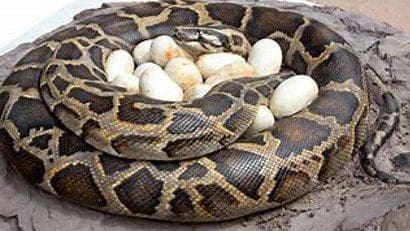
Unlike most other types of hunting, I had no idea how to prepare for a python hunt. I started by doing what all responsible hunters should do: research the targeted species. In Florida, pythons are not protected, except by anti-cruelty law. They can be humanely killed on private lands at any time with landowner permission without a permit. Pythons may also be humanely killed in different Wildlife Management Areas, Public Small Game Hunting Areas and Wildlife and Environmental Areas. There is no bag limit and pythons can be taken by any means other than traps or firearms (unless provided for by specific area regulations).
It probably doesn’t come as surprise to learn that pythons are not native to Florida. In 1992, Hurricane Andrew devastated the Florida coast. The category five storm caused 65 human fatalities and an estimated $26.3 million in damage. At the time, it was the costliest storm in Florida history. Unfortunately, the damage caused by Hurricane Andrew would have far-reaching consequences that no one could have imagined.
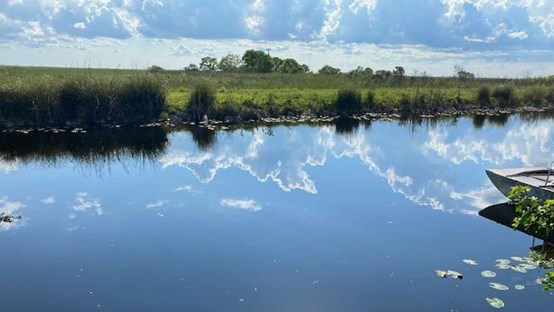
Several exotic pet wholesalers lost entire python inventories in the storm. This mass exodus quickly overwhelmed the ecosystem. The Burmese python is native to Southeast Asia. Since the climate of the Florida Everglades is very similar to Southeast Asia, the species thrived. Now, the python is an invasive species that has tragically altered its new home. With no natural predators, the snakes are now at the top of the Everglades food chain.
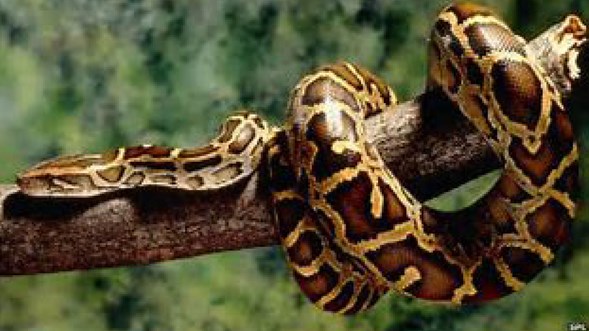
Biologists estimate that there are more than 300,000 Burmese pythons in the Florida Everglades. In one study alone, between 1997 and 2012, the raccoon population dropped 99.3 percent, opossums dropped 98.9 percent and bobcats dropped 87.5 percent. Rabbits and foxes have nearly vanished from the ecosystem. Pythons are egg-laying reptiles, capable of depositing up to 100 eggs per clutch. With the decline of predators such as raccoons, opossums and foxes, there is a low mortality rate for the reptile eggs, allowing the species to further flourish.
Burmese pythons are non-venomous constrictors. Constrictors kill by seizing prey in its powerful jaws, then looping its body around the victim. The python tightly coils around the body, squeezing tighter every time the prey exhales until it can no longer breathe. The coils of the snake also apply so much pressure that it prevents the blood in its prey from circulating and carrying oxygen to the brain and other organs.
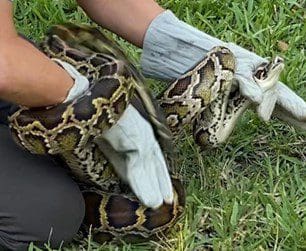
Python hunting in Florida is typically done at night with a bright spotlight. Pythons can usually be spotted along the edge of waterways by driving levees or cruising in shallow boats. Here’s the general way it goes down: Once a python is spotted, you capture the snake with your hands. Look for an opportunity where the snake is moving away from you in a straight direction, with the head unprotected. If the python is not presenting its head for a quick grab, position yourself near the snake while avoiding the potential strike zone, which is about 1/3 to 1/2 of its body length in any direction, and wait for your opportunity. Get down on your knees and quickly grasp the head slightly behind the jawbone, applying pressure to prevent an escape. Anticipate the python to coil and constrict. While low to the ground, offer the snake your thigh to coil around rather than allowing the python to coil up your arm, which presents the python a greater potential to break free of your grip. It is always recommended to have another individual with you while hunting for pythons to assist in a safe capture.
When python hunting, there are several safety procedures that must be followed. You should always hunt with at least one other person. When a snake is captured alive it can quickly overpower its handler. It is possible for a very large Burmese python to injure an adult by constriction.
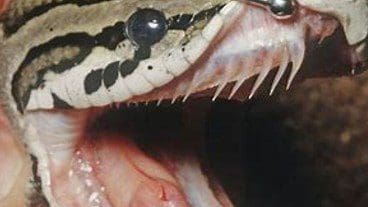
Another factor is the design of the snake’s mouth, which is very large and contains four rows of teeth in the top jaw and two rows of teeth in the bottom jaw. The teeth of the Burmese python are also angled back. So, if this species of snake grabs you, it is very difficult to extract the part of the body in its mouth. It takes the help of a second person to assist in prying open the jaws to help someone who has been bitten escape.
When python hunting, you should also be aware of the possibility of other threats. These include alligators, native venomous snakes and other larger predators that might be in the area. The hunter should wear long pants, long-sleeved shirts, closed-toed shoes or boots and heavy leather gloves. Do not forget that you are in the swamp; make sure you bring insect repellant.
Burmese pythons, although large reptiles, are extremely difficult to find. The color and pattern of the python’s skin is designed to help it blend into surrounding vegetation, allowing this powerful ambush predator to remain virtually undetected when potential prey animals are near. Because these snakes can be difficult to spot and require specific handling guidelines, I participated in a thorough presentation about the species. There, I had the opportunity to practice capturing and safely handling a “practice” python.

After a few successful captures and with boosted confidence, I was anticipating nightfall so the hunt could begin! We loaded into a large pick-up truck outfitted with spotlight bars mounted high around the perimeter of the cab, illuminating the dirt road ahead of us and both sides of the vehicle. As we drove into the night, we searched the edge habitat where the marsh meets the land, hoping to find one of these invasive nuisances.
Just like any other hunting opportunity, you don’t always find success at the end of the day, or in this case, night. My guide suspected passing thunderstorms had a negative effect on our search. Nonetheless, I learned more than anticipated and had an experience I will never forget!
